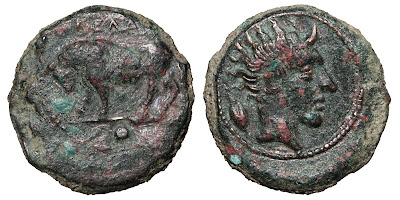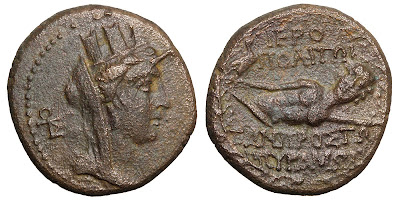 |
| Bronze onkia of Gela in Sicily |
The river gods bore the same names as their rivers. These two coins show examples. On the right is a small coin from Gela in Sicily, still an important town situated on the river of the same name. The coin dates from the end of the 5th century BCE. It illustrates a common conception of rivers and their gods; that they had the unstoppable force of a charging bull. A butting bull is on one side of this coin.
The other side shows the youthful river god Gela, and you can see two unusual things about him. First, he has horns — this gives him personally some bull-like attributes. In fact, sometimes the river gods were shown as bulls with human heads. And second, his strange hair. This spikiness is a representation of the way hair floats up when you are under water. The river-god Gela is in his element.
The second coin is from Hieropolis-Kastabala in Cilicia, now southern Turkey. It sat on the river Pyramos, now called the Ceyhan River. It is a little later than the coin from Gela, dating from the 2nd or 1st century BCE.
 |
| Bronze AE22 of Hieropolis-Kastabala in Cilicia |
On the obverse of this coin is Tyche, the city goddess. This was a common way of representing a deity specific to a city. Although these city goddesses looked similar, they were not the same goddess; each city had its own. She is wearing a mural crown, a crown that represents the walls of the city. Numismatists say she is "turreted" — an odd bit of jargon.
The reverse shows the river god of the Pyramos. He is swimming to the right, and holding an eagle in one hand. (It is definitely supposed to be an eagle, even if it does look more like a duck.) This coin has a longish Greek legend; IEPOΠOΛITΩN TΩN ΠPOΣ TΩI ΠYPAMΩI. It means "(Coin of) Hieropolis of the people who dwell on the Pyramos." It was probably put this way to distinguish it from other towns also called Hieropolis.
One reason I like ancient coins is that so much is going on on them.
This second coin has been stripped of its patina, probably by electrolysis. The exposed surface is somewhat irregular and pitted. This is a shame; it would probably have looked much better if it had been cleaned more carefully, leaving the patina in place.
I have a web page about river god coins here: River Gods on Ancient Coins.
No comments:
Post a Comment